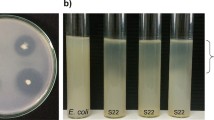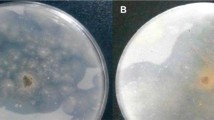Abstract
In this study, fungi isolated from soil were screened for their ability to form clear zones on agar plates with emulsified poly(ε-caprolactone) (PCL). The most active strain, designated as DSYD05, was identified as Penicillium oxalicum on the basis of morphological characteristics and phylogenetic analysis. Mutant DSYD05-1, obtained by ultraviolet-light mutagenesis from strain DSYD05, was more effective in PCL degradation. In liquid cultures of the mutant strain with PCL emulsion, DSYD05-1 showed the highest PCL-degrading activity after 4 days of cultivation. The products of PCL degradation were analysed by mass spectrometry; the results indicated that 6-hydroxyhexanoic acid was produced and assimilated during cultivation. The degradation of PCL film by DSYD05-1 was observed by scanning electron microscopy, and was indicative of a three-stage degradation process. The degradation of amorphous parts of the film preceded that of the crystalline center and then the peripheral crystalline regions. In addition, DSYD05-1 showed a wide range of substrate specificity, with capability to degrade PCL, poly(β-hydroxybutyrate), and poly(butylene succinate), but not poly(lactic acid), indicating that the strain could have potential for application in the treatment or recycling of bio-plastic wastes.






Similar content being viewed by others
References
Anderson AJ, Dawes EA (1990) Occurrence, metabolism, metabolic role, and industrial uses of bacterial polyhydroxyalkanoates. Microbiol Rev 54:450–472
Cho HS, Moon HS, Kim M, Nam K, Kim JY (2011) Biodegradability and biodegradation rate of poly(caprolactone)-starch blend and poly(butylene succinate) biodegradable polymer under aerobic and anaerobic environment. Waste Manage (Oxford) 31:475–480
Ci SQ, Chen S, Liu DB, Xia HM (2006) An extracellular poly (3-hydroxybutyrate) depolymerase from Penicillium sp. DS9713a–01. World J Microbiol Biotechnol 22:729–735
Cook WJ, Cameron JA, Bell JP, Huang SJ (1981) Scanning electron microscopic visualization of biodegradation of polycaprolactones by fungi. J Polym Sci Polym Lett Ed 19:159–165
Eldsater C, Erlandsson B, Renstad R, Albertsson AC, Karlsson S (2000) The biodegradation of amorphous and crystalline regions in film-blown poly(ε-caprolactone). Polymer 41:1297–1304
Fukushima K, Abbate C, Tabuani D, Gennari M, Rizzarelli P, Camino G (2010) Biodegradation trend of poly(ε-caprolactone) and nanocomposites. Mater Sci Eng C 30:566–574
Gross RA, Kalra B (2002) Biodegradable polymers for the environment. Science 297:803–807
Hirotsu T, Ketelaars AAJ, Nakayama K (2000) Biodegradation of poly(ε-caprolactone) -polycarbonate blend sheets. Polym Degrad Stab 68:311–316
Hoang KC, Tseng M, Shu WJ (2007) Degradation of polyethylene succinate (PES) by a new thermophilic Microbispora strain. Biodegradation 18:333–342
Khatiwala VK, Shekhar N, Aggarwal S, Mandal UK (2008) Biodegradation of poly(ε-caprolactone) (PCL) film by Alcaligenes faecalis. J Polym Environ 16:61–67
Kim DY, Rhee YH (2003) Biodegradation of microbial and synthetic polyesters by fungi. Appl Microbiol Biotechnol 61:300–308
Kong HZ (2007) Flora fungorum sinicorum. Science Press, Beijing
Li F, Wang S, Liu WF, Chen GJ (2008) Purification and characterization of poly(L-lactic acid)-degrading enzymes from Amycolatopsis orientalis ssp.orientalis. FEMS Microbiol Lett 282:52–58
Maeda H, Yamagata Y, Abe K, Hasegawa F, Machida M, Ishioka R, Gomi K, Nakajima T (2005) Purification and characterization of a biodegradable plastic-degrading enzyme from Aspergillus oryzae. Appl Microbiol Biotechnol 67:778–788
Murphy CA, Cameron JA, Huang SJ, Vinopal RT (1996) Fusarium polycaprolactone depolymerase is cutinase. Appl Environ Microbiol 62:456–460
Murphy CA, Cameron JA, Huang SJ, Vinopal RT (1998) A second polycaprolactone depolymerase from Fusarium, a lipase distinct from cutinase. Appl Microbiol Biotechnol 50:692–696
Nakamura K, Tomita T, Abe N, Kamio Y (2001) Purification and characterization of an extracellular poly(L-lactic acid) depolymerase from a soil isolate, Amycolatopsis sp. strain K104–1. Appl Environ Microbiol 67:345–353
Nishida H, Tokiwa Y (1993) Distribution of poly(β-hydroxybutyrate) and poly(ε-caprolactone) aerobic degrading microorganisms in different environments. J Environ Polym Degrad 1:227–233
Oda Y, Asari H, Urakami T, Tonomura K (1995) Microbial degradation of poly(3-hydroxybutyrate) and polycaprolactone by filamentous fungi. J Ferment Bioeng 80:265–269
Oda Y, Oida N, Urakami T, Tonomura K (1997) Polycaprolactone depolymerase produced by the bacterium Alcaligenes faecalis. FEMS Microbiol Lett 152:339–343
Schober U, Thiel C, Jendrossek D (2000) Poly(3-hydroxyvalerate) depolymerase of Pseudomonas lemoignei. Appl Environ Microbiol 66:1385–1392
Sekiguchi T, Saika A, Nomura K, Watanabe T, Watanabe T, Fujimoto Y, Enokia M, Sato T, Kato C, Kanehiro H (2011) Biodegradation of aliphatic polyesters soaked in deep seawaters and isolation of poly(ε-caprolactone)-degrading bacteria. Polym Degrad Stab 96:1397–1403
Shimao M (2001) Biodegradation of plastics. Curr Opin Biotechnol 12:242–247
Tokiwa Y, Calabia BP, Ugwu CU, Aiba S (2009) Biodegradability of plastics. Int J Mol Sci 10:3722–3742
Tseng CL, Chen HJ, Shaw GC (2006) Identification and characterization of the Bacillus thuringiensis phaZ Gene, encoding new intracellular poly-3-hydroxybutyrate depolymerase. J Bacteriol 188:7592–7599
Tseng M, Hoang KC, Yang MK, Yang SF, Chu WS (2007) Polyester-degrading thermophilic actinomycetes isolated from different environment in Taiwan. Biodegradation 18:579–583
Tsuji H, Kidokoro Y, Mochizuki M (2006) Enzymatic degradation of biodegradable polyester composites of poly(L-lactic acid) and poly(ε-caprolactone). Macromol Mater Eng 291:1245–1254
Wei JC (1979) Fungus handbook. Shanghai Science & Technology Press, Shanghai
Zhang MC (1984) Industrial micro breeding. Science Press, Beijing
Acknowledgments
This work was supported by National Natural Science Foundation of China (Grant No. 31100046).
Author information
Authors and Affiliations
Corresponding author
Rights and permissions
About this article
Cite this article
Li, F., Yu, D., Lin, X. et al. Biodegradation of poly(ε-caprolactone) (PCL) by a new Penicillium oxalicum strain DSYD05-1. World J Microbiol Biotechnol 28, 2929–2935 (2012). https://doi.org/10.1007/s11274-012-1103-5
Received:
Accepted:
Published:
Issue Date:
DOI: https://doi.org/10.1007/s11274-012-1103-5




